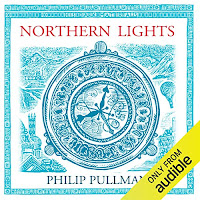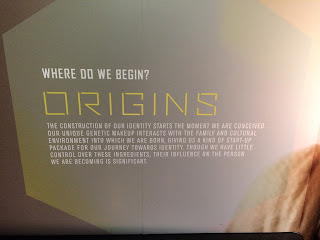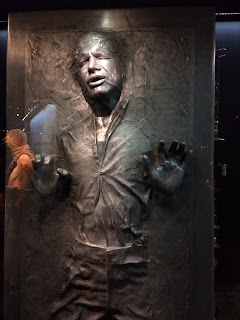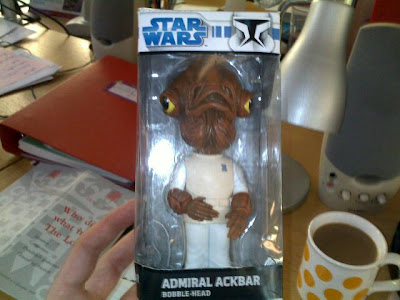“The tall white-haired man lay still as death. The girl leaning over him could find no pulse, no beat from either of his hearts. His skin was icy cold to the touch.” (p. 7)
This is the Doctor, near-dead on a couch in the TARDIS following the events of his previous, thrilling adventure. The girl — his friend Jo Grant — helpfully recounts for our benefit what’s been going on. Sometime “far into the future”, she and the Doctor had stumbled on,
“a plot to cause a space war. The Doctor discovered his old enemy the Master involved in the plot — and behind the Master were the Daleks. Although the Doctor managed to defeat the Master and prevent the war, he was seriously wounded in a Dalek ambush. I managed to get him into the TARDIS.” (p. 8)
There is no asterisk and footnote to “See Doctor Who and the Space War” by Malcolm Hulke, which was the Doctor Who novelisation published directly before this one — on 23 September. And that’s probably just as well, because Jo’s summary is not at all what happens at the end of that book. There is no Dalek ambush; the Doctor is in perfect health when he leaves in the TARDIS.
In part, I think the mismatch is because Mac and Terrance both worked from scripts, not the stories as broadcast. But working through this discrepancy is revealing of other things, too.
Doctor Who and the Space War is based on a 1973 TV story called Frontier in Space, which was written by Malcolm Hulke and script edited by Terrance. The Daleks appear in the final episode but depart long before the end. They are not even on the same planet when the last few scenes take place so there is not even a chance of an ambush. Instead, in the closing moments, the Master confronts and tries to shoot the Doctor. The Doctor switches on a machine that makes nearby Ogrons think that a monster is attacking. In the confusion, the Master’s hand is knocked just as he fires his gun.
In Hulke’s script for the episode, this meant that the Master entirely missed the Doctor. The Master then ran off, pursued by other characters. The Doctor, in perfect health, decided not to follow, telling Jo that they needed to prioritise going after the Daleks. We were to see them both enter the TARDIS, it would dematerialise and the credits would roll.
This was how the scene was recorded on 31 October 1972. But then producer Barry Letts decided that the end of the story needed reworking, not least because the monster had not been realised well. Terrance, as script editor, was tasked with reworking the sequence. He was able to add new material so long as it involved solely the Doctor and Jo. Actors Jon Pertwee and Katy Manning recorded this new material on 22 January 1973, on the same day as recording Episode One of the next story to be broadcast, Planet of the Daleks.
In the revised and broadcast version, when the Doctor switches on his machine and the Ogrons react, we don’t see to what. They bump into the Master but his shot now hits the Doctor, who falls to the ground. As the others rush off, Jo leans over the prone Doctor, amazed to discover that he is still alive; jogging the Master’s arm meant it was only a glancing blow. Jo helps the Doctor to his feet and into the TARDIS. We see the interior, with the gravely wounded Doctor on his feet at the console, sending a telepathic message to the Time Lords to ask for help in pursuing the Daleks.
In novelising his own TV story, Hulke worked from the camera scripts — ie the last versions used in recording of the episode in October 1972. But these, obviously, included the monster, and the Doctor not being hit. What’s more, Hulke further amended the closing moments of the story to address something else.
Due to the untimely death of actor Roger Delgado in June 1973, Frontier in Space had been his final onscreen appearance as the Master. On screen, he is rather lost in the confusion of the amended scene, but it wasn’t much of an exit for such a significant character, played by such a well-liked man. In the novelisation, Hulke gives Delgado a proper send off.
As per the script, the Doctor working the machine makes the Ogrons see a monster — Mac describes it as a “giant, Ogron-eating lizard, rearing up its great head”, not the pink fabric bag featured in recording. The Ogrons rush off, bumping into the Master so that he drops his gun — which the Doctor now picks up. The Master, his “face contorted with fear”, asks if the Doctor will shoot him. Jo says he can’t, not in cold blood, but the Doctor ushers her into the TARDIS. He has to tell her twice before she complies.
The two Time Lords are now alone, one at the mercy of the other. The Master thinks the Doctor will shoot. It’s a tense moment as we turn to the very last page of the book, where the Doctor says that he won’t kill his old enemy. He should really take him prisoner but has to get after the Daleks. So he throws the gun harmlessly to one side.
“The Master grinned. ‘Perhaps we shall meet again, Doctor.’
‘Yes, perhaps we shall.’
The Doctor closed the door of the TARDIS. The Master watched as it dematerialised. Then he went back to his big table and started to collect his star charts and other papers. ‘Oh well,’ he said to himself, ‘there’s always tomorrow.’” (Doctor Who and the Space War, by Malcolm Hulke, p. 142).
It’s a lovely send-off, perfectly capturing Delgado’s Master and the relationship with Pertwee’s Doctor. That last line is funny yet bittersweet if we know that there wasn’t a tomorrow, and the two never met again. What a deft bit of writing.
Of course, it doesn’t match what happens at the start of Planet of the Daleks — on screen or in the book. As broadcast, the first episode begins by reprising the closing moments of Frontier in Space, ie the revised ending that Terrance wrote. Our first sight is of the Doctor lying on the floor outside the TARDIS having just been shot, with Jo leaning over him. Amazed he is still alive, she helps him to his feet and through the door. Inside, he sends his telepathic message, then collapses across the console. Jo finds him somewhere to lie down: a pull-out bed rather than a couch.
Terrance keeps that opening shot — the Doctor lying prone, Jo leaning over him — but simplifies the action by having this happen inside the TARDIS, the telepathic message already sent. This means he doesn’t have to explain where the TARDIS is when the Doctor is lying outside it. He can quickly bring us up to speed on what’s happened and concentrate on what happens next.
This simplification of action may explain why he has the Doctor wounded by an ambush of Daleks — the antagonists in the story to follow — and not being shot by the Master, who doesn’t feature in what’s to come.
The alternative is that Terrance didn’t recall his own rewrite of the closing scene of Frontier in Space. Hulke — his friend and sometime neighbour — might have reminded him, if they’d consulted one another in writing their novelisations. But it doesn’t look as though they compared notes. Other examples include the fact that Terrance is vague about the setting of his novelisation beyond it being, “far into the future” (pp. 7-8), while Mac’s opening sentence is definitive: “The year 2540.”
But then why wasn’t the discrepancy between the end of Hulke’s novelisation and the start of Terrance’s picked up by the editorial team at Target?
I wonder if, in fact, the brief from the publisher was not to collaborate, to ensure that each book could stand on its own. Neither book features a plug for the other, either in a footnote or among back-page ads.
On p. 2 of my first edition of Doctor Who and the Planet of the Daleks, the preceding Doctor Who and the Space War is cited last in the long list of other novelisations available, but with no indication that it has any particular link with this book. (Poor Doctor Who and the Giant Robot is still absent from the list.)
Nor is there anything in the cover art of these two books to suggest a link between them, though they are by the same artist and presumably completed one after the other.
 |
| 1982 reprint of Doctor Who and the Planet of the Daleks; 1984 reprint of Doctor Who and the Space War |
Doctor Who and the Space War is the first novelisation to feature the Third Doctor where he doesn’t appear on the cover. The focus is an Ogron, all the more imposing for being seen from below and dramatically lit, and more detailed than the photograph on which it is based:
 |
| Reference photo used for the cover of Doctor Who and the Space War c/o Black Archive |
Behind the Ogron is a vista of planets and twinkling stars. The planets are lit from one side, the crescent of the light making them three dimensional. We can see the traces of craters and other surface detail.
Below this are two inset images: the head of a Draconian and a spacecraft in a cloud of steam. The Draconian is pale green — matching the logo of the first edition. The rest of the image is in tones pink and purple-brown. The muted colours, the fine linework and airbrushed colour are, I think, in the style of grown-up science-fiction titles of the time. Not quite Chris Foss, but in that direction.
By contrast, the cover for Doctor Who and the Planet of the Daleks is in a much more comic-strip style, with the blasts of energy, thunderbolts and stippled effects characteristic of Achilleos’s early work for the series. Instead of looking up at a single central figure, we look straight on at a Dalek framed on either side by the Doctor and the Thal called Taron. The Doctor is leant forward, face in profile; we see more of Taron’s agonised face. It’s a much more dynamic composition, the Doctor’s posture leaning into the Dalek, as well as the direction of the sucker arm and gun stick, giving a sense of movement from left to right.
ETA Richard Long on Bluesky suggests the photograph that Achilleos worked from, as below. We can see how Achilleos has reworked elements of the composition, notably the eyestalk. Also, compared to what we see on TV, where this moment happens in a beige-coloured quarry in winter, it’s all much richer and brighter.
The bright red logo is in contrast to the blue background (for some reason, we can’t see the blue through the middle of the “O” in “Who”). The illustration is otherwise variously brown, green, orange, purple, red, yellow, as well as grey, black and white. It’s full of colour and there are details to pick over — such as the orange sparks dripping vertically from the Dalek gunstick as it fires a blast of energy off the right of frame. Yet above Taron’s head, a planet is depicted as a simple red spot.
The difference in styles between the two covers is, I think, comparable to the difference between the work Achilleos did on the first 12 novelisations for Target and the new look brought in my Peter Brookes. It has to be conscious, doesn’t it? Why would the artist — and publishers — want to keep these two books separate?
I think we can understand why. It’s one thing to say at the end of Doctor Who and the Revenge of the Cybermen, when the Cybermen have been entirely defeated and the story wrapped up, that the Doctor’s next adventure will take place in Scotland, with a footnote “See Doctor Who and the Loch Ness Monster” — a wholly new adventure. Likewise, the first edition of Doctor Who and the Giant Robot contains a footnote referencing the as-yet unpublished Doctor Who and the Planet of the Spiders. This directly precedes the events of the Robot story, but each book is its own, self-contained adventure. You don’t miss anything by reading just one of the books.
The TV stories Frontier in Space and Planet of the Spiders are something different: two halves of a an epic single story. In commissioning them in the first place, Terrance partly had in mind the example of the 12-episode The Daleks’ Master Plan (1965-66), also written by two writers taking half the episodes each.
That was fine on TV, where no further payment was required. But I can see why the publishers might have been nervous about conveying any sense that a book, or two books, contained just 50% of a story. These were novelisations that children bought for themselves, often from their own pocket money. It would not do to be seen to exploit that.
One other thing to note about Doctor Who and the Space War before we dig into the book that Terrance wrote: it is the last novelisation to change the title of the story as used on screen.
Now, Frontier in Space is perhaps not the most thrilling title, and a frontier is steeped in old-fashioned ideas of empire. But the story, notably, doesn’t feature a space war — it is threatened but avoided. As we’ve seen, previous changes to the titles used on TV emphasised the names of the monsters in the story. So why not call this “The Ogron Plot” or something similar?
In the handwritten list of forthcoming novelisations included on p. 92 of Keith Miller’s The Official Doctor Who Fan Club vol. 2, and written a little before August 1975, the story is listed as “The Frontier in Space” — apart from the “the”, as on screen. It had changed by the following year, when it was listed as “The Space War” in the July 1976 issue of fanzine TARDIS.
By then, there was news of a big-budget science-fiction movie being filmed in the UK for release the following year. For example, the London Evening News reported on 24 March 1976 that,
“one of the most expensive films ever to be made in Britain begins shooting this week — at a cost of more than £7 million. … The title: Star Wars. The theme: a war between three worlds [sic].” (p. 5.)
The same paper had another story on the film on 19 April (p. 15), and I’ve found accounts in other papers. There was, to some degree, hype.
And note that detail in the new report about the war between three worlds. That’s also the plot of Frontier in Space, with a conflict between planets Earth and Draconia being plotted from the planet of the Ogrons. Did the publishers, or the canny Malcolm Hulke, make that connection? If so, was the title and style of cover art used on Doctor Who and the Space War an attempt to cash in on Star Wars — more than a year before its UK release?
It would be very Doctor Who to pinch ideas from the future...
*
In Part II, I dig deeper into what Terrance wrote in Doctor Who and the Planet of the Daleks. There is swearing, fleshy parts that spit milky liquids, and also an orgy…































